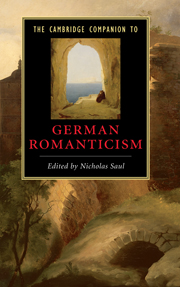Book contents
- Frontmatter
- 1 What is Romanticism, and where did it come from?
- 2 From early to late Romanticism
- 3 Prose fiction of the German Romantics
- 4 The Romantic lyric
- 5 The Romantic drama
- 6 Forms and objectives of Romantic criticism
- 7 Romanticism and Classicism
- 8 Women writers and Romanticism
- 9 The Romantics and other cultures
- 10 Love, death and Liebestod in German Romanticism
- 11 Romantic philosophy and religion
- 12 Romantic politics and society
- 13 Romantic science and psychology
- 14 German Romantic painters
- 15 Romanticism and music
- 16 Transformations of German Romanticism 1830-2000
- Key authors and their works
- Further reading
- Index
1 - What is Romanticism, and where did it come from?
Published online by Cambridge University Press: 28 September 2010
- Frontmatter
- 1 What is Romanticism, and where did it come from?
- 2 From early to late Romanticism
- 3 Prose fiction of the German Romantics
- 4 The Romantic lyric
- 5 The Romantic drama
- 6 Forms and objectives of Romantic criticism
- 7 Romanticism and Classicism
- 8 Women writers and Romanticism
- 9 The Romantics and other cultures
- 10 Love, death and Liebestod in German Romanticism
- 11 Romantic philosophy and religion
- 12 Romantic politics and society
- 13 Romantic science and psychology
- 14 German Romantic painters
- 15 Romanticism and music
- 16 Transformations of German Romanticism 1830-2000
- Key authors and their works
- Further reading
- Index
Summary
Since the significance and history of German Romanticism is embedded in an exceptionally complex configuration of sociopolitical, religious and aesthetic phenomena, this chapter comprises three sections. The first focuses on the larger historical and political context of the Romantic movement in Germany, the second on the philosophical, cultural and aesthetic coordinates of German Romanticism, and the final section investigates the critical aesthetics of the Jena or early German Romantics, as articulated in the fragments and aphorisms of the journals Lyceum der schönen Künste (1797) and Athenaeum (1798-1800). The term 'Romanticism', as defined in this chapter, refers predominantly to the eighteenth- and nineteenth-century concept of an era informed by the profound experience of momentous political, social and intellectual revolutions. The term also has its own history, which calls for a short introduction. The etymology of the word 'Romantic' can be traced to the old French romanz, which referred to the vernacular 'romance' languages, Italian, French, Spanish, Catalan, Portuguese and Provençal, which were developed from Latin. Subsequently, tales of chivalry, written in one of these romance languages, came to be known as medieval romance or romaunt. These were often composed in verse and narrated a quest. Later, the authors of the Middle Ages and the Renaissance, such as Dante, Ariosto, Torquato Tasso, Cervantes and Shakespeare, who abandoned classical forms, were seen as inventors of a romantic, fantastical style. In the eighteenth century, the semantic field of the word 'romantic' in common English usage had expanded to include the picturesque, the fanciful and the fantastic with not altogether positive connotations.
- Type
- Chapter
- Information
- The Cambridge Companion to German Romanticism , pp. 1 - 20Publisher: Cambridge University PressPrint publication year: 2009
- 12
- Cited by



